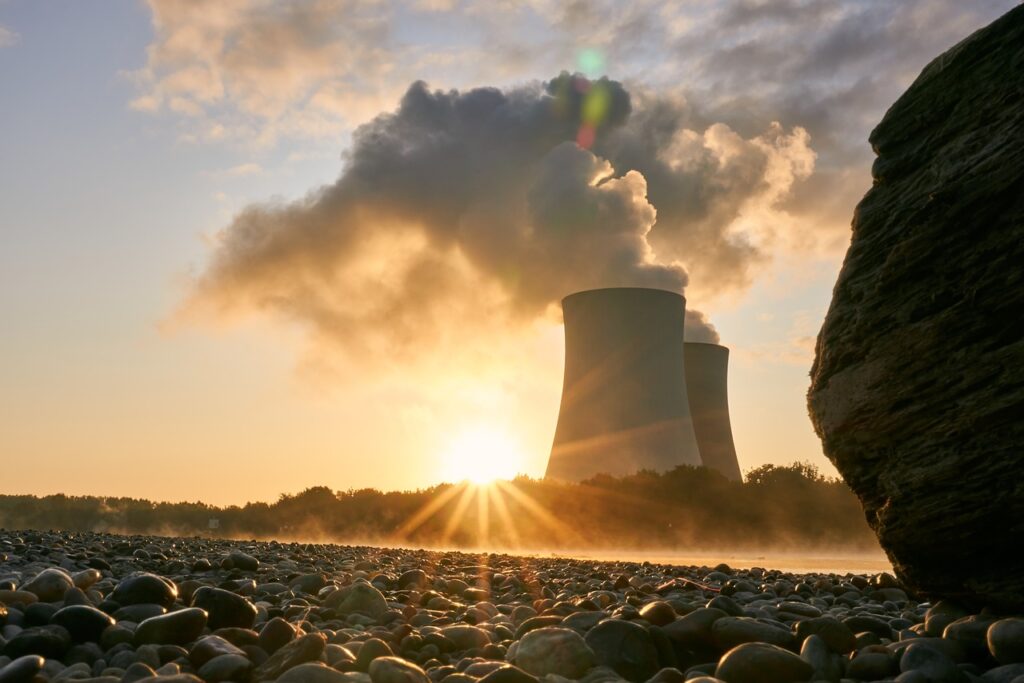
| The very short answer to that question is: no. Now here’s the longer answer. Building enough nuclear power plants to make a meaningful reduction in greenhouse gas emissions would cost trillions of dollars and create tens of thousands of tons of deadly radioactive waste. Where and how will that dangerous waste be stored? We still don’t have a sufficient answer to that question, 70 years after the first nuclear power plant went online. Time is a factor. The climate emergency demands that we reduce reliance on fossil fuels for energy to 0% by 2050, but even according to nuclear power lobbyists (the World Nuclear Association and the OECD Nuclear Energy Agency) if we doubled nuclear capacity worldwide by 2050 the greenhouse gas reduction would only amount to about 4%… and that would require adding 37 new large reactors to the grid every year from now until then. Currently each nuclear power plant takes an average of fourteen years to build; utility-scale wind and solar farms take about two to five years to build. Contrast that with the timescale for adding dispatchable battery storage: battery storage equivalent to the output of 20 nuclear reactors has been connected to the US electric grid in just the past four years. The Federal Energy Information Administration (EIA) predicts that this capacity could double again to 40GW by 2025. And then there’s the cost perspective. If we want to address the climate emergency, what’s the most efficient business case? According to a Lawrence Berkeley National Laboratory report, the Levelized Cost of Energy (LCOE) for utility-scale solar power generation averages around $45 per megawatt-hour (MWh) nationwide; onshore wind power averages around the same, with costs varying by location. Compare those costs with nuclear energy, with LCOE per MWh ranging from $112 to $189. But what about those Small Modular Reactors (SMRs) that have been touted as the next big thing? In spite of huge federal subsidies, that prospect has yet to yield results. After years of research and development, only one company, NuScale, managed to win design approval from the U.S. Nuclear Regulatory Commission. But as the projected user cost per megawatt-hour jumped 53 percent, surpassing average costs for solar and wind energy, the developers of the “Carbon Free Power Project” in Idaho, which would have been the first deployment of an SMR in the United States, pulled the plug on the project. SMRs can’t change the calculus. These smaller reactors are significantly less expensive than large reactors, but their energy output is also much less, resulting in an even greater cost per kWh than their large reactor cousins. The cost per kWh for renewables continues to fall; even if SMR costs comes down over future years of development and deployment, it will be a long time, if ever, before they can compete on cost. There have also been plans to recommission closed large nuclear plants, including the infamous Three Mile Island plant that disastrously melted down in 1979. It’s another strategy with many of the same drawbacks. John Ketchum, CEO of NextEra, the energy company looking at reopening the closed Duane Arnold nuclear power plant in Iowa, was quoted as saying “There are only a few nuclear plants that can be recommissioned in an economic way, and newer technologies like small modular reactors remain financially infeasible.” He continued, “But even with a 100% success rate on those recommissionings, we would still only meet less than 1% of that [new electricity] demand.” Nuclear is just not a viable solution to the climate crisis. It’s far too expensive, much too slow to deploy, and it diverts funding from much more effective and more efficient clean energy technologies. And we haven’t even begun to talk about safety issues, including potential radiation leaks, meltdowns, and the fact that nuclear installations make an attractive target for terrorism or acts of war, as we’ve seen in Ukraine and Russia. |